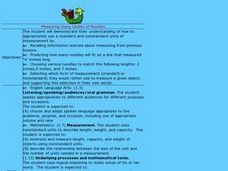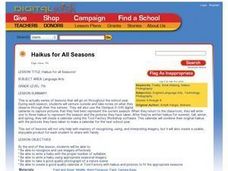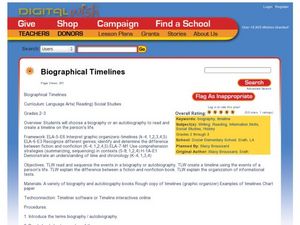Curated OER
Extending Vocabulary to Describe Communities
Second graders study vocabulary to describe their community. In this meaning of words lesson, 2nd graders acquire new vocabulary words to label pictures and objects. They use these words in speaking and writing.
Curated OER
Identifying Bullies
Students investigate human behavior by defining bullies. For this psychology lesson, students read the book Just One Flick of a Finger, and discuss why bullies act out in front of other children. Students investigate actions...
Curated OER
Sounding Out CVCE Words
First graders explore vowels and consonants by participating in a flash card activity. In this phonetics lesson, 1st graders discuss the difference between short and long vowels and identify them within a story told to them by their...
Curated OER
Critical Thinking & Writing: Brainstorming
Have your young writers organize their thoughts before writing. They generate ideas through various brainstorming activities prior to writing a mock feature news story for USA Today. A series of USA Today articles debating the level of...
Curated OER
The Five Senses
Study various objects and help kindergarteners use their five senses to classify the objects. They are presented with various objects and then use their five senses to sort and classify the objects. Then they use a Visual Ranking Tool to...
Curated OER
Effective Speaking in a Debate
Students examine and discuss the concept of stage fright. They demonstrate positive debate techniques, constructively critique other speakers, and implement debate techniques for a practice debate.
Curated OER
Create a Cookbook
Trios write, design, and produce cookbooks. In a truly collaborative project, they choose what content to include, contribute recipes, and decide on formatting. Then, they reformat all recipes to ensure consistent style, publish the...
Curated OER
Measuring Using Oodles of Noodles
First graders explore and evaluate the use of both standard and nonstandard forms of measurement. They use noodles to measure the lengths of each line they have drawn. They glue the noodles to the page under the given line.
Curated OER
Rate Your Plate
Third graders analyze the nutrients, calories, and food groups using the USDA CNPP website Interactive Healthy Eating Index. They write a summary of their personal findings related to their eating habits - including some ways to improve...
Curated OER
Rhetoric and War
Young scholars examine the relationship between rhetoric and war. In this history of war lesson, students analyze paintings, photographs, movies, and articles that paint an opinionated picture of war. Young scholars...
Curated OER
Population - Technical Reading
Students analyze a technical article about population growth and present possible solutions.
Curated OER
Show and Tell
Students practice their speaking skills by sharing information during show and tell about one object. Before giving their speech, they must analyze the relationship and space between them and the audience. They are evaluated by a...
Curated OER
What About Us? Women in the Civil War
Students research the role of women in the Civil War. In this Civil War unit, students research the role women played during the war. This unit includes eight different activities including vocabulary, writing prompts and a literature...
Curated OER
It's Your Future
Learners learn about productive resources along with their requirements, supply and demand, savings, investments and interest rates. In this supply and demand activity, students create a career plan and personal budget of their own and...
Curated OER
KWL Chart
Students create a KWL chart on a selected nonfiction topic using a variety of strategies. They infer the answers to four questions, identify a purpose for reading, list four or more things about the topic, and list four or more answers...
Curated OER
Civil War on Sunday
Third graders read "Cvil War on Sunday" together and discuss characters, setting, problem and resolution. They determine facts from fiction used in the story and research drummer boys in the Civil War or Clara Barton using the Internet....
Curated OER
Picture Perfect
Students work together in groups to research Afghanistan in the 1970s and today. After reading a story about a Peace Corps volunteer, they discuss things they must do in their community they believe are unneccessary. They end the...
Curated OER
The Very Hungry Caterpillar
Visually represent a retelling of the story by writing and illustrating their own Hungry Caterpillar book.Observe and describe the life cycle of a butterfly.Also, observe caterpillars, record growth rates and changes over time.
Curated OER
Technology: The State of the Internet
Students develop ratings criteria for evaluating Websites. Once they brainstorm lists of qualities for Websites, students, in pairs, browse various Maine Websites and create evaluation systems. As a follow-up activity, students may...
Curated OER
Stating Your Position
Students make a formal effective presentation proclaiming the position benefits before a simulated governmental hearing. They objectively rate the accuracy and effectiveness of presentations given before a simulated governmental hearing.
Curated OER
Haikus for All Seasons
Students venture outside and take notes on what they observe through their five senses. They use the Olympus D-545 digital cameras to capture pictures that they feel best represent the current season. Students write one to the three...
Curated OER
Celebrating Diversity
Students gain a better understanding about cultures. They find similarities and differences between cultures. Various resources ranging from web sites to trade books to email addresses of people are provided. This lesson incorporates...
Curated OER
Digital Parts of Speech
High schoolers investigate different parts of speech by creating digital skits. In this digital education activity, students collaborate in groups to research the Internet for clips and music that represent the different parts of speech....
Curated OER
Biographical Time lines
Students create a time line. In this biography lesson, students define biography and autobiography and then read short examples of each. Students create a time line using a read aloud.

























